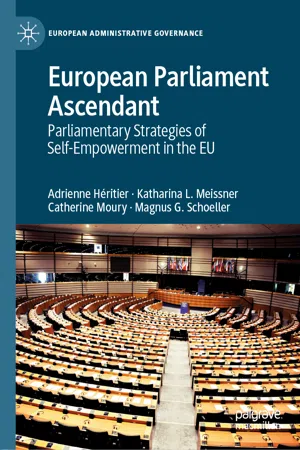In recent decades, the European Parliament (EP) has been extremely skilful in pushing forward its agenda for widening its institutional powers at the heart of European democratic decision-making. When interacting with the other institutions, the Commission and the Council of Ministers, the EP considerably widened its powers in the crucial areas of legislation, electing the Commission and shaping the budget. From initially a minor institutional actor it grew to be a coequal partner actor with the Council in most areas.
At the outset, the Council of Ministers was the main legislator in the European polity, with the exception of the right of initiative of the Commission. The Assembly, later the directly elected EP, has over time grown from a minor partner in legislation into a full co-legislator with the Council of Ministers under the ordinary legislative procedure. When electing the Commission, whose members are proposed and nominated by member state governments, the EP has to confirm the Commission in its entirety and can use a vote of no confidence . In practice, today, the EP proposes candidates for the Commission President through the so-called Spitzenkandidaten procedure and must give its formal approval of the Commission President, while the individual Commissioners are dependent on the agreement of a majority in the EP. In the budgetary process, finally, the EP has over time gained increasing competences and now is a coequal partner to the Council as regards expenditure, but not as regards revenues.
This raises the questions: Why has the EP been successful in widening its formal and informal powers in these crucial decision-making processes? Which strategies did it employ in order to increase its powers vis-à-vis the other institutions and under which conditions do these strategies succeed or fail? Moreover, how do the EP’s strategies of institutional empowerment play out in substantive policy areas?
An important body of literature has analysed the impact of EP empowerment on inter-institutional cooperation and conflict. This research, for example, looks at the effect of treaty changes on real power distribution across the Commission, the EP and the Council (Tsebelis and Garret 2000; König 2008). Others focus on the cooperation between those three institutions (Huber and Shackleton 2013; Mühlböck 2013; Mühlböck and Rittberger 2015), among other stressing the important role of the rapporteur (Benedetto 2005) or the increasing use of ‘early agreements’ (Toshkov and Rasmussen 2012; Reh et al. 2013; De Ruiter and Neuhold 2012).
What concerns us in this book, however, are the causes of the EP’s widening powers. For that purpose, it is useful to distinguish between two different kinds of arguments. On the one hand, it has been argued—by both rationalists and constructivists—that the widening of parliamentary powers emanates from the preferences of (strong) executives. Rational choice scholars explain member states preferences for EP empowerment with a cost-benefit calculation regarding the power distribution across the three institutions (König 2008) or by the desire to ‘lock in’ existing ideological configurations in the future (Moravcsik and Nicolaïdis 1999). Executive preferences are seen to be shaped by national actors and interests (Moravscik 1998) and by European decision-rules such as unanimity (Scharpf 1988); and in some cases, such restrictions play in favour of the EP. This is the case with the constraints imposed on executives by national parliaments, for example, as some of those saw the empowerment of the EP as a means to ‘regain’ power they had lost at the EU level (Haroche 2018). Similarly, the specific institutional rules of the ‘Convention for the future of Europe’ (Roederer-Rynning and Schimmelfennig 2012) constrained executives to ‘constitutional legal coherence’ that benefited the EP in agriculture policy. A more norm-based argument states that legitimacy concerns are the main driver of member states’ support for a stronger EP (Rittberger 2003, 2005, 2012); and that in some cases—such as for policy areas in which qualified majority voting is used—the empowerment of the EP is even ‘taken for granted’ by policy makers (Goetze and Rittberger 2010).
A second set of explanations focuses on the EP’s own role (which is the perspective we endorse in this book). Starting from the assumption that treaties are ‘incomplete contracts’ open to interpretation, it has been argued that most changes in power distribution are the result of a bargaining game in which the EP directly participates. In this game, the EP has strong assets which consist, for example, in a lower sensitivity to policy failure and a longer time horizon than the Council or the Commission (Farrell and Héritier 2005; Héritier 2007). In that context, scholars have identified a series of strategies used by the EP to win institutional battles. An important strategy is the withholding or delaying of its consent to legislation (Hix 2002; Héritier 2007; Farrell and Héritier 2005), the budget (Héritier 2007; Lindner 2006; Lindner and Rittberger 2003) or the nomination of the Commission candidate (Hix 2002; Moury 2007). Another successful strategy is that of ‘linking areas’ (Héritier 2007), which refers to conditioning the approval of a policy in one arena to obtaining more institutional powers in ...
